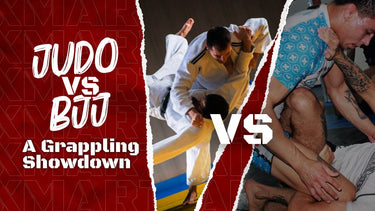
The martial arts world has long been captivated by the eternal debate: Judo vs BJJ? These two grappling arts, each with its unique strengths and philosophies, have attracted countless practitioners seeking mastery. But which one is truly more effective? Let's dive into the world of Judo and BJJ to determine which martial art reigns supreme.
Origins and Evolution
Judo: A Japanese Legacy
Judo, meaning "the gentle way," was developed in Japan by Jigoro Kano in the late 19th century. Drawing inspiration from traditional Japanese Jiu-Jitsu, Kano created a martial art and sport that emphasized leverage, control, and moral development. It became an Olympic sport and is best known for its dynamic throws and pins.
BJJ: A Gracie Family Legacy
Brazilian Jiu-Jitsu (BJJ) stems from Judo's groundwork, brought to Brazil by Mitsuyo Maeda, a student of Kano. The Gracie family adapted these techniques, creating a distinct martial art focused on positional control and submissions. BJJ became globally recognized through the Gracie Challenge and its dominance in early UFC events.

Judo vs BJJ: Key Differences
Techniques: Throw vs Flow
Judo aims to unbalance and throw opponents using maximum efficiency. Techniques like seoi-nage and osoto-gari dominate in competition. Groundwork exists but is less emphasized due to rule constraints.
BJJ flips the emphasis—practitioners pull guard or initiate takedowns, then work through positions like mount and back control to secure submissions like armbars, chokes, and joint locks.
Rules, Striking & Sport Format
- Judo: Strictly prohibits striking. Matches are usually won by executing a clean throw (ippon) or pin. Newer rules favor stand-up action, limiting groundwork.
- BJJ: No striking either, but far more freedom on the ground. Matches reward positional control and submissions. Strategies can vary from explosive to methodical.
Pros and Cons
Pros of Judo
- Mastery of balance and explosive movement
- Excellent for self-defense with throws
- Olympic sport with global recognition
Cons of Judo
- Less focus on ground grappling
- Restrictive modern competition rules
Pros of BJJ
- Deep emphasis on ground control and submissions
- Adaptable to any body type or fitness level
- Effective for MMA and self-defense
Cons of BJJ
- Less emphasis on takedowns or stand-up
- Longer learning curve for new students
Effectiveness for Self-Defense and MMA
Both Judo and BJJ can be highly effective for self-defense and street fighting. Judo's emphasis on throws and takedowns can be advantageous in real-world situations, while BJJ's focus on grappling and submissions can help neutralize an opponent on the ground.
In mixed martial arts (MMA), both Judo and BJJ have been highly successful. Many of the world's top MMA fighters have a strong background in either Judo or BJJ, demonstrating their effectiveness in a full-contact combat sport.
Essential Gear
Judo Gi: A traditional Japanese martial arts uniform consisting of a jacket and pants. Judo gis are typically made of cotton and have a stiff collar.
BJJ Gi: are similar to judo Gi but often have a looser fit and may feature additional features like rubberized grips.
Rash Guards: are compression garments worn underneath the gi to provide comfort and protection.
Mouthguards: Both Judo and BJJ require mouthguard to protect teeth and jaw during training and competition.
Belts: Belts are used to indicate rank and proficiency in both Judo and BJJ.
Tournament Rules
Judo: Judo competitions typically consist of multiple rounds, with the goal of scoring points through throws, pins, and submissions. The first competitor to score ippon (full-point victory) wins the match.
BJJ: BJJ competitions focus on ground grappling and submissions. Matches are typically won by submission, points, or superior position.
Judo vs BJJ: Training For Kids
Both Judo and BJJ offer numerous benefits for children, making them excellent choices for developing valuable skills and character traits. While Judo emphasizes throws and takedowns, BJJ focuses on grappling and submissions. The best martial arts for your child depends on their individual interests and preferences.
Consider trying both Judo and BJJ to see which one resonates more with your child. The most important thing is to find a martial art that your child enjoys and benefits from. Remember, the goal is to foster a lifelong passion for martial arts and provide a positive learning experience.
By exposing your child to both Judo and BJJ, you're giving them the opportunity to explore different styles and find the one that best suits their individual needs. Ultimately, the most important factor is to choose a martial art that your child enjoys and feels confident in.
Conclusion
The choice between Judo and BJJ ultimately depends on individual preferences and goals. Both martial arts offer unique benefits and can be highly effective for self-defense, competition, and personal development. By understanding the key differences between these two grappling arts, you can make an informed decision about which one is right for you.
